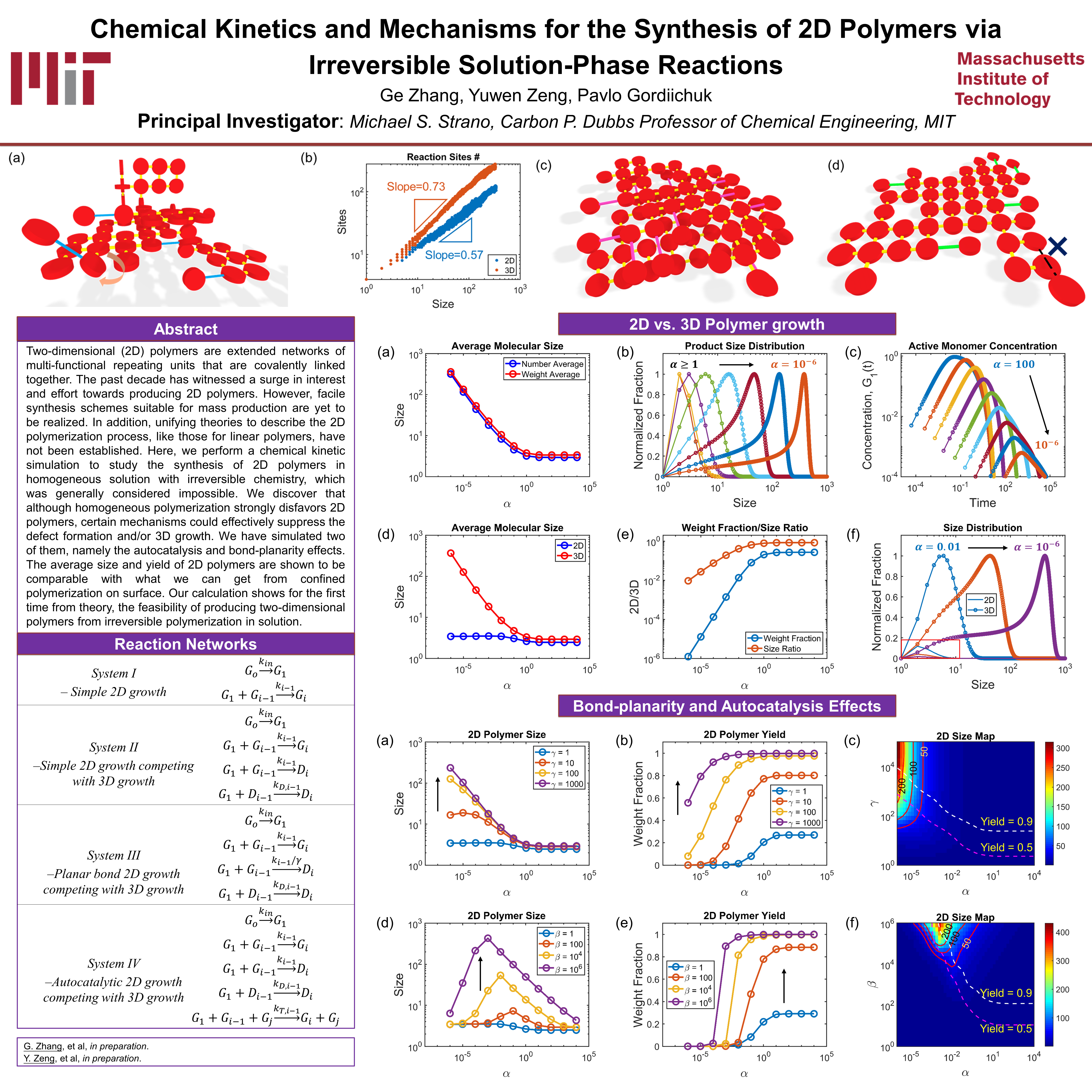(649e) Chemical Kinetics and Mechanisms for the Synthesis of 2D Polymers Via Irreversible Solution-Phase Reactions
AIChE Annual Meeting
2020
2020 Virtual AIChE Annual Meeting
Materials Engineering and Sciences Division
Polymer Synthesis and Reaction Engineering
Friday, November 20, 2020 - 8:45am to 9:00am
In this work, we propose and compare two possible mechanisms for making two-dimensional polymers from irreversible reactions in solution phase: the autocatalysis effect, and the bond-planarity effect. Autocatalysis could be achieved by self-templated growth on the surface of as-formed 2D molecules, which increases the rates of 2D growth; while bond-planarity would limit the bond rotation and therefore reduce the probability of 3D growth. By modelling the reaction networks as systems of differential equations, we are able to calculate the reaction time, the size distribution function of the product, and the yield of 2D polymer. The autocatalysis and bond planarity effects are parametrized by two factors: β and γ, respectively.
The results show that both mechanisms can significantly increase the size and yield of 2D polymer, and suppress the formation of 3D product. Without the aid of either effect, the average size of 2D polymer will be minuscule (<10), and the yield is negligible. In contrast, when either of the two effect is strong enough (β>104 and γ>103), a yield close to unity and a much larger average size (>100) could be achieved for 2D polymer. We find that bond-planarity effect would limit the bond rotation and therefore restore the behaviour of 2D polymerization confined to a plane. On the other hand, autocatalysis could dramatically increase the rates of 2D growth, which leads to sizes even bigger than the ideal 2D polymerization without competition from 3D growth. We also study the combined effect of both mechanisms, and obtain further enhancement in the average size (>1000) and near-unity yield, indicating a potential synergy between the two factors.
Our calculation show for the first time from theory, the feasibility of producing two-dimensional polymers from irreversible polymerization in solution. The framework is independent of the detailed pathways of reactions and structures/functionalities of molecules, hence the results are expected to be general and applicable for all types of 2D polymerization process that happen irreversibly in solution. Latest experimental work from our group has successfully demonstrated the synthesis of mechanically strong 2D polymer from irreversible polymerization in solution, via the bond-planarity mechanism, which provides validation for our calculation.
Reference:
[1] S. B. B. Alahakoon, S. D. D. Diwakara, C. M. M. Thompson, R. A. A. Smaldone, Chem. Soc. Rev. 2020, 49, 1344.
[2] S. Bi, C. B. Lu, W. B. Zhang, F. Qiu, F. Zhang, J. Energy Chem. 2018, 27, 99.
[3] J. W. Colson, W. R. Dichtel, Nat. Chem. 2013, 5, 453.
[4] J. Lopez-Cabrelles, S. Manas-Valero, I. J. Vitorica-Yrezabal, P. J. Bereciartua, J. A. Rodriguez-Velamazan, J. C. Waerenborgh, B. J. C. Vieira, D. Davidovikj, P. G. Steeneken, H. S. J. van der Zant, G. M. Espallargas, E. Coronado, Nat. Chem. 2018, 10, 1001.
[5] Y. Zhong, B. R. Cheng, C. Park, A. Ray, S. Brown, F. Mujid, J. U. Lee, H. Zhou, J. Suh, K. H. Lee, A. J. Mannix, K. Kang, S. J. Sibener, D. A. Muller, J. Park, Science 2019, 366, 1379.
[6] E. Sandoz-Rosado, T. D. Beaudet, J. W. Andzelm, E. D. Wetzel, Sci. Rep. 2018, 8, 3708.
[7] H. Y. Li, A. D. Chavez, H. F. Li, H. Li, W. R. Dichtel, J. L. Bredas, J. Am. Chem. Soc. 2017, 139, 16310.
[8] B. J. Smith, W. R. Dichtel, J. Am. Chem. Soc. 2014, 136, 8783.
[9] A. M. Evans, L. R. Parent, N. C. Flanders, R. P. Bisbey, E. Vitaku, M. S. Kirschner, R. D. Schaller, L. X. Chen, N. C. Gianneschi, W. R. Dichtel, Science 2018, 361, 53.
[10] E. L. Spitler, W. R. Dichtel, Nat. Chem. 2010, 2, 672.
[11] L. Grill, S. Hecht, Nat. Chem. 2020, 12, 115.
[12] L. Lafferentz, V. Eberhardt, C. Dri, C. Africh, G. Comelli, F. Esch, S. Hecht, L. Grill, Nat. Chem. 2012, 4, 215.
[13] K. J. Liu, H. Y. Qi, R. H. Dong, R. Shivhare, M. Addicoat, T. Zhang, H. Sahabudeen, T. Heine, S. Mannsfeld, U. Kaiser, Z. K. Zheng, X. L. Feng, Nat. Chem. 2019, 11, 994.
[14] W. Liu, X. Luo, Y. Bao, Y. P. Liu, G. H. Ning, I. Abdelwahab, L. J. Li, C. T. Nai, Z. G. Hu, D. Zhao, B. Liu, S. Y. Quek, K. P. Loh, Nat. Chem. 2017, 9, 563.
[15] J. W. Colson, A. R. Woll, A. Mukherjee, M. P. Levendorf, E. L. Spitler, V. B. Shields, M. G. Spencer, J. Park, W. R. Dichtel, Science 2011, 332, 228.
[16] G. R. Newkome, P. S. Wang, C. N. Moorefield, T. J. Cho, P. P. Mohapatra, S. N. Li, S. H. Hwang, O. Lukoyanova, L. Echegoyen, J. A. Palagallo, V. Iancu, S. W. Hla, Science 2006, 312, 1782.
[17] P. Kissel, R. Erni, W. B. Schweizer, M. D. Rossell, B. T. King, T. Bauer, S. Gotzinger, A. D. Schluter, J. Sakamoto, Nat. Chem. 2012, 4, 287.
[18] P. Kissel, D. J. Murray, W. J. Wulftange, V. J. Catalano, B. T. King, Nat. Chem. 2014, 6, 774.
[19] M. J. Kory, M. Worle, T. Weber, P. Payamyar, S. W. van de Poll, J. Dshemuchadse, N. Trapp, A. D. Schluter, Nat. Chem. 2014, 6, 779.
